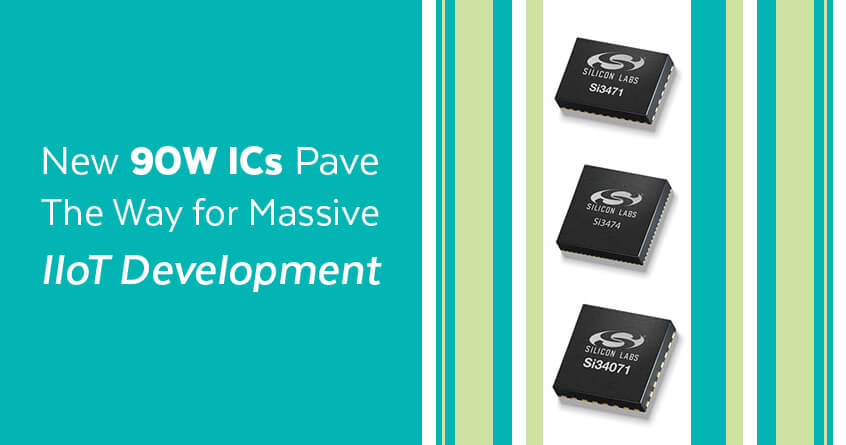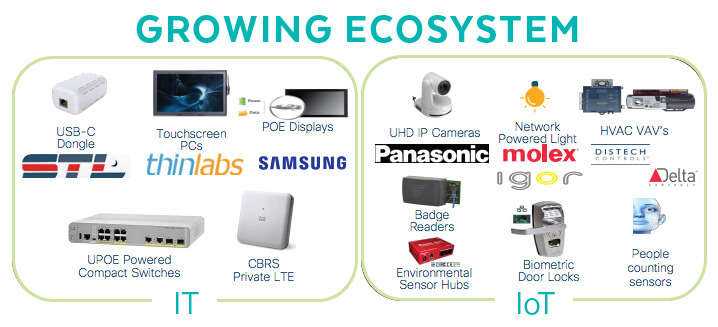Silicon Labs (NASDAQ: SLAB) recently announced a portfolio of three new integrated circuits (IC) that deliver up to 90W of Power over Ethernet (PoE) per port from Power Sourcing Equipment (PDE) to Power Devices (PDs). Safe delivery of 90W over one cable enables the speedy implementation of a host of IoT technologies. Smart technology is becoming increasingly sophisticated and more power-hungry, and the most that industrial IT and IoT communities have been able to get on a single port, until recently, has been 60W. IEEE 802.3bt takes a big step forward with 90W (UPoE++).
This blog will talk a little bit about these chips and explore some of the industrial IT and IIoT devices that these babies will support.
The New Silicon Lab ICs
The March 2020 release includes the Si3471, the Si3474, and the Si34071. In case you’re new to the discussion, ICs can perform a variety of functions within the design of electronic equipment. They can function as memory, microprocessors, and microcontrollers.
The Si3471, a PSE controller, is the industry’s first fully autonomous, 90-W, single-port 802.3bt-compliant power-sourcing device. Because it is fully-autonomous, the Silicon Labs chip eliminates the need for additional:
- Firmware downloads
- Software programming
Developers will have fewer headaches building out the full range of capabilities because so much of the integration work has already been done.
Microcontrollers are intended for low power and low processing applications. That makes them an ideal solution for PoE PSEs. They are essentially an optimized one-chip solution for a one-cable implementation. They consume less power and take up less space inside of a single port device like an injector or media converter.
The Si3474 is a quad Ethernet-port PSE controller. It takes the upscale delivery of the Si3471 and expands it from one port to four ports. It consumes less power and takes up less space inside of a switch or hub.
- Four 90W, 802.3bt PoE ports or up to eight 30W 802.3at/af PoE ports
- Suitable for Ethernet switches and security recording equipment use in industrial and commercial settings.
The Si34071 single-chip PD device.
- Combines an 802.3bt interface with an integrated, high-efficiency dc-dc converter capable.
- Powers 5G small cells, wireless access points, and IoT gateways.
- This chip appears on the receiving end of the first two chips.
To appreciate the importance of these breakthrough ICs, here’s a list of some of the equipment where 90W PoE is going to benefit.
The Growing 90W PoE Ecosystem
Image comes from a Cisco PowerPoint on Intent-based Networks.
The types of industrial PDs these ICs support split into two basic groups:
- Technology used in industrial IT
- Technology used in industrial IoT
Let’s take a closer look at what they will make available to the industrial end-user.
How 90W Benefits Industrial IT
The industrial IT technologies appear as part of an industrial network. They allow workers and other machines to communicate in settings like production floors, construction sites, mining operations, transportation lines, and power stations.
PoE Display Screens
These are output devices used for presenting information around a facility or transit center to communicate changing information to workers or travelers. Having 90W capabilities will allow larger screens to be deployed in larger spaces.
PoE Power Sourcing Devices
Most commonly switches, PSEs connect together all of the devices on a network. In the case of PoE, they not only transmit data they also deliver power. They function as the backbone of all industrial networks and are an essential part of powering all of the devices listed in this blog.
Having 90W capabilities expands the variety of devices connected to one network.
Touchscreens
Touchscreens provide digital access points to networks within manufacturing and heavy industrial areas. They are both input and output devices and a convenient way to control machinery during operations from key places around a work zone.
How 90W Benefits Industrial IoT
These technologies appear in the industrial space and will make production safety and security easier and quicker to implement. The following is a list of some of these technologies that will make a better quality of life for those workers.
Alert Systems
Horns and sirens are early warning devices that allow workers to safely evacuate in the event of a fire or other emergency hazards. The new 90W capability will enable technology developers to deliver more features within these systems.
Badge Readers
Badge readers are designed to read information encoded on small cards and control access to secure areas within a manufacturing facility. They can also be built into keyboards and other aspects of security systems.
Biometric Door Locks
Biometric Door Locks use the unique biological characteristics of an individual like fingerprints to authenticate identity. They allow organizations to secure work areas on job sites from corporate spying and close off hazardous areas from intruders.
Commercial VAV Air Handling Systems
Variable Air Volume (VAV) is a type of smart airflow system that uses sensors to determine the amount of airflow at a constant temperature that is needed to heat and cool buildings. By regulating air volume to a zone (open or close damper), it controls the amount of air conditioning that flows to specific areas.
Environmental Sensor Hubs
Sensor systems help protect workers in dangerous environments like mines and production floors. They detect shifts in temperature, humidity, smoke, and airflow. They can also detect intrusion at access points where security protocols have been violated.
UHD IP Cameras
UHD IP Cameras feature advanced 8-megapixel image sensors (4x the pixels of 1080p HD) and can capture more light to improve color, contrast, and brightness. They are especially valuable in security deployments as the images they capture offer significant levels of clarity. These devices are valuable in helping lean manufacturing teams spot areas for improvement and increase operational efficiency.
Final Thoughts
While Silicon Labs is the first to market, they are by no means the last. As the industrial IT and IIoT continue to develop, it’ll be interesting to see what other ICs developers produce. The end result, though, is going to be more power per device and faster data speeds. We will step further into autonomous technology and 5G, and witness greater security and adaptability in the way we work.
For the latest blogs and product updates, follow PLANET on Facebook, Twitter, and Instagram.

